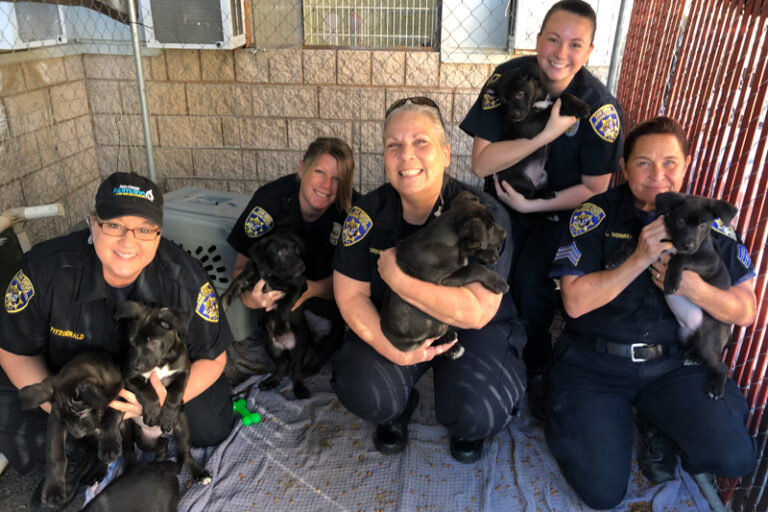Volunteers are the heart and soul of a community-centered animal shelter. They drive the organization’s mission, vision, and values, and make it possible for a shelter to expand its support for people and pets; to keep more families together and save more lives.
Now, while so many shelters are full and then some, plus understaffed, volunteers are especially needed.
Which got us wondering—how are shelters recruiting volunteers, and keeping them excited and engaged, through this time?
We asked, you answered! Below are eight great tips we hope you’ll check out and try. And like always, we want to hear from you, too.
Reach out and tell us about how you’re integrating volunteers into your organization—or anything else that’s on your mind! Get in touch at marketing@americanpetsalive.org.
Send out volunteer surveys—and pay attention to what they say.
Every October, Pasco County Animal Services‘s volunteer & foster care coordinator Sarah Sukhram sends out an annual volunteer survey. The survey is anonymous, and asks a mix of questions, like “What do you value most when volunteering at PCAS?” and “What’s one area of opportunity that you’d like to see improve in the new year?”
The survey’s existence conveys to volunteers that their thoughts and ideas matter. It also elicits actionable information.
For example, last year, Pasco learned that volunteers didn’t know that shifts were flexible in terms of time.
“We lost so many high school volunteers that didn’t know our 2-5 dog walker shift could be allowed to start at 3 based on when school releases,” Sarah says. “Little things like that, which are often not worth them bringing up to me in their minds, but actually was an issue as a whole that we didn’t communicate correctly.”
Jessica Munoz-Roper of Best Friends Animal Society showed us a survey that volunteers can fill out at any time. It’s simple, asking just three questions.
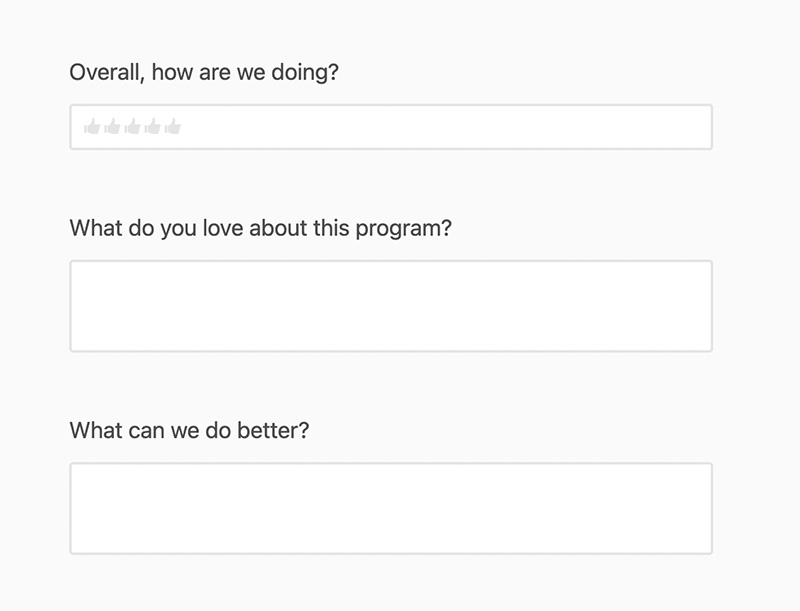
“We also try to foster a lot of psychological safety and dialogue, so we get a lot of feedback through routine communications,” Jessica says. “We have chat channels for each volunteer role, plus a ‘live’ (virtual) team meeting each month.”
Be welcoming and patient, and bring candy.
One regular volunteer at her local city shelter told us that the shelter’s welcoming attitude keeps her coming back.
“The entire staff at my shelter has always been very welcoming and patient with me and all of my questions,” Jennette Schuhmann wrote in the American Pets Alive! Shelter and Rescue Support Facebook group. “This might seem obvious but for me this really goes a long way. They make me feel like I am important and appreciated just by our interactions at the shelter.”
Jennette feels so positive about her experience that she now helps recruit other volunteers, too.
Jackie Harjula, volunteer coordinator for Pope Memorial Humane Society in Maine, keeps fresh flowers and a candy bowl in the volunteer office, just as an added way to show appreciation. This is in addition to staff “constantly thanking volunteers,” and Jackie calling volunteers on their birthdays.
“Unless they move out of town or their hours for work change, we don’t lose many of our volunteers,” Jackie says.
Recruit volunteers online, especially for jobs that can be done remotely. And lots of jobs can be done remotely!
Amy Shever is founder and executive director of 2nd Chance 4 Pets, an organization that encourages pet owners to create plans for the pets’ care should they outlive their owners.
2nd Chance has a host of virtual volunteer positions—and recruits for them on websites like volunteermatch.org.
Amy estimates she’s found more than 3,000 volunteers through volunteermatch.org, since 2003.
“From the time I post a new volunteer opportunity, I usually hear from several people interested in applying within 48 hours,” Amy says. “There has always been an untapped community of people who prefer to volunteer remotely.”
This blog from Rescue Allies has more ways to recruit volunteers.
Give out special shirts for volunteers who put in the time.
When volunteers complete 50 hours of service, Pasco County Animal Services mails a letter to their home thanking them for volunteering, with a voucher for a free orange shirt.
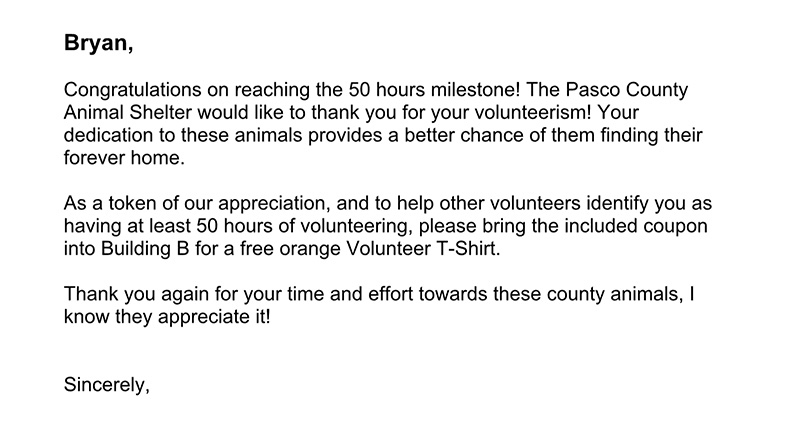
“Our shirts are available for sale, but the orange color is exclusive to those who reach the 50 hour mark,” says Pasco’s Sarah Sukhram. “This helps build that excitement of the volunteers reaching the 50 hours, they enjoy wearing it to show other volunteers that they have experience, and the biggest feedback I get is that they enjoy getting a physical letter in the mail rather than an email or text.”
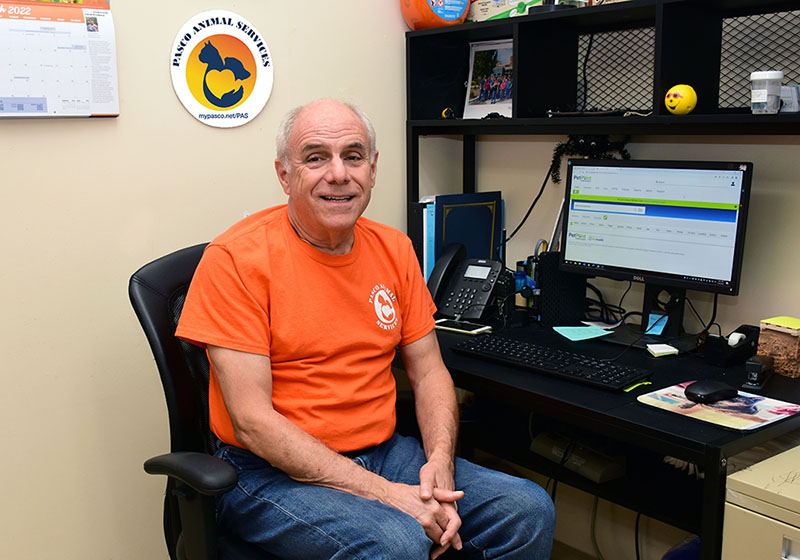
Personalize the volunteering experience.
When Sara Groce became the volunteer programs manager for Brother Wolf Animal Rescue in Asheville, North Carolina, in 2021, she took responsibility for finding ways to make the program run more smoothly and to make volunteering more of a priority for the organization.
One of the ways Sara did this was by “personalizing” the volunteering experience. This begins with a conversation, during which new volunteers are asked about their goals. “If they’re in it for a specific reason (i.e. college resumes, volunteer hour requirements, etc.), if they’re just looking for something to fill up their free time, or if they are unemployed, between jobs, or retired and are looking to make a more significant volunteer commitment to us,” Sara says.
The next step is seeing where the volunteer will best fit into the organization. Some volunteers, especially those who aren’t working, are scheduled “like part-time jobs,” Sara says. “We also have a ton of working volunteers who tell me when they can volunteer, and we build shifts into our schedule based on their availability whenever possible. But the majority of our volunteers just want to sign up for shifts whenever their schedule allows.”
There are downsides. Sometimes shifts don’t get filled, “or we’re in a pinch and we don’t have any volunteers on deck in case we have a last-minute volunteer need,” Sara says. But she believes that this is a worthwhile tradeoff.
“Eighty percent of the volunteers who do a first shift end up coming back for more shifts in the future, and that is so great,” she says.
Create training videos that can be watched any time.
A lot of organizations have moved their volunteer orientations and trainings to Zoom, since the pandemic. The Humane Society for Tacoma & Pierce County in Washington is moving toward recording its orientation videos, to make it even easier for volunteers to participate.
It’s a work in progress—one digital marketing manager Stefanie Cornell is feeling very optimistic about. “We believe this could increase volunteer interest and instead of potential volunteers dropping interest waiting for about a month for orientation, they can do orientation right away,” Stefanie says.
Deploy your Nextdoor Ambassadors.
The Humane Society for Tacoma & Pierce County’s Nextdoor Ambassadors are volunteers who sign up to post shelter campaigns, events, and other information in their Nextdoor neighborhood.
“Our marketing team writes up content and shares graphics with the volunteers who then post as ambassadors of the shelter in their neighborhood groups,” says Stefanie. “We also provide frequently asked questions and answers and if any volunteer receives comments they aren’t sure how to answer, we are happy to encourage them to contact us and we provide them with a response that they can use if they’d like. It’s a great way to promote the shelter to an audience that might not regularly see our content.”
Interested? This Steal This Idea blog is about LifeLine Animal Project’s Nextdoor Ambassador program—and how your organization can start one, too!
Create a volunteer group for veterans.
A few years ago, Jacksonville Humane Society in Florida was looking for a way to expand the number of playgroups its dogs could get into every day. With multiple military bases in the area, creating a volunteer program specifically for veterans seemed a natural fit. The veterans are supported in their transition out of the military life, while supporting dogs who are transitioning into another life, too, explains JHS CEO Denise Deisler.
The Paws & Stripes program is such a success that it’s now expanded into a job training program, as well—the Paws & Stripes Academy is a 4-week training program, which leaves participants positioned to work in the animal field upon graduation. It’s a job opportunity—and an effort to address understaffing.
“Veterans provide the support of a traditional volunteer while learning the pathway to a new career as they transition from the military into the civilian sector,” the program leader, Army veteran Kevin Kane, told station WOKV this summer.
Denise suggests other organizations that want to create a volunteer program for veterans—or another group—start off small, and give it a try. “Dip your big toe in the water,” she says.
JHS has other volunteer opportunities for specific groups, too, including a corporate program and a job training program for high school students. Are there groups of people in your community you could build a volunteer program around?
While you’re here: Be sure to take a look at the Human Animal Support Services Volunteer Integration toolkit—which is chock full of tips, tools, and resources to help you engage volunteers in every part of your organization!
And here’s the Volunteer Integration communications kit, created by HASS in partnership with HeARTs Speak. This kit, like all the communications kits in our series, is designed to help you talk to your community about how your organization supports people and pets, and how anyone can be part of that mission. It contains fully customizable graphics, media pitches, talking points, sample social media posts, and much more. It’s all completely free to use, and can be easily tailored to your organization’s and community’s needs!
